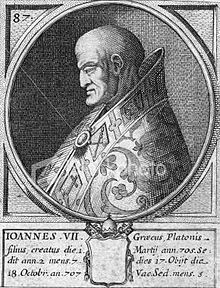Pope John VII
|
Pope John VII |
|
|---|---|
 |
|
| Papacy began | 1 March 705 |
| Papacy ended | 18 October 707 |
| Predecessor | John VI |
| Successor | Sisinnius |
| Personal details | |
| Born | 650 Rossano in Calabria, Byzantine Empire |
| Died | 18 October 707 |
Pope John VII (Latin: Ioannes VII; c. 650 – 18 October 707) was Pope from 1 March 705 to his death in 707. The successor of John VI, he was (like his predecessor) of Greek ancestry. He is one of the popes of the Byzantine Papacy.
John was a native of Rossano in Calabria. His father, Plato (c. 620 – 686), was imperial cura palatii urbis Romae, or curator of the Palatine Hill. This makes John the first pope to be the son of a Byzantine official. His mother was called Blatta (c. 627 – 687). His paternal grandfather was Theodorus Chilas (c. 600 – aft. 655), a Senator in 655.
John VII had good relations with the Lombards, who then ruled much of Italy. However, his relations with Justinian II, the Byzantine Emperor, were far from smooth. Papal relations with Byzantium had soured over the Quinisext (or Trullan) council of 692. Scholarly debate contests John VII's stance on the Canons. He did not ratify the Canons, which were deeply unpopular in Italy. Nonetheless, he was criticized, most unusually, by the Liber Pontificalis for not signing them:
He [Emperor Justinian II] despatched two metropolitan bishops, also sending with them a mandate in which he requested and urged the pontiff [John VII] to gather a council of the apostolic church, and to confirm such of them as he approved, and quash and reject those which were adverse. But he, terrified in his human weakness, sent them back to the prince by the same metropolitans without any emendations at all.
Several monuments in Rome are connected with John. The most notable is the Church of St. Maria Antiqua at the foot of the Palatine Hill. Traces of an episcopal palace Episcopium associated with John have been discovered upon the Palatine. John VII also constructed an Oratory dedicated to the Theotokos. The Oratory was located within the Old basilica of St. Peter. Fragments of the mosaic decoration can be found in the Vatican grottoes. Furthermore, a sizeable icon, known as the Madonna della Clemenza and housed in Santa Maria in Trastevere, is believed to have been commissioned under the patronage of John. He also restored the monastery of Subiaco, destroyed by the Lombards in 601.
...
Wikipedia
